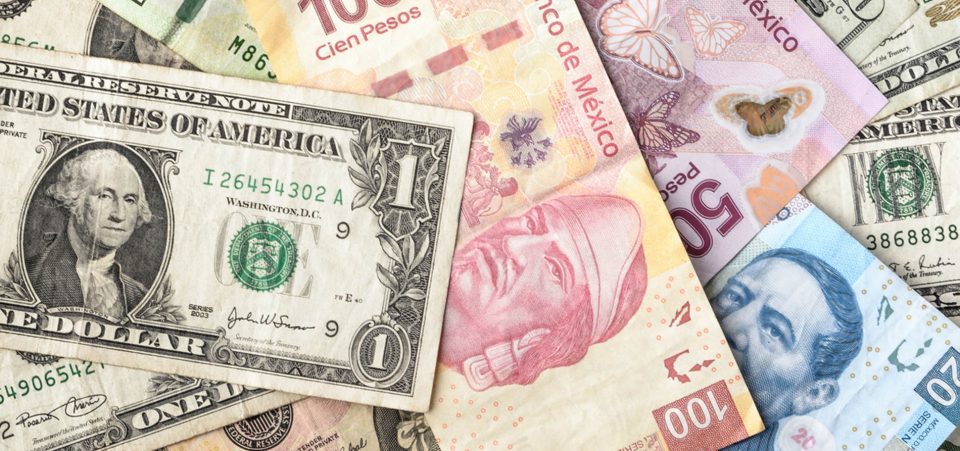Donald Trump Leaves Little Room for the Peso. The USD to MXN Forecast Is Bearish in the Long Term
Now that Donald Trump has officially become the 45th President of the United States, you would expect the Mexican peso to be plunging. The USD to MXN forecast did take an expected bearish turn on the day before the inauguration. But, there was a surprise.
The Mexican peso took a dive off the famed La Quebrada cliff in Acapulco on January 19. But just when you thought it would sink, the Mexican peso rebounded just a day before the inauguration. The USD to MXN forecast had an “unreality” check, as it saw one of the peso’s best single-day performances against the dollar ever (+0.9%).
It’s true that the volumes seemed weak, magnifying the effect of individual trades. It must have caught peso short sellers off guard, forcing them to close their positions. Still, given the extent of Trump’s accusations against Mexico and his solutions, the Mexican peso forecast might be easier to determine than other currencies.
The Mexican peso has presented itself as one of the more interesting currencies to watch in 2017. The basic formula for understanding the USD to MXN forecast: if Trump softens the tones on these fronts, the weight (yesterday lows on record for the second session in a row) could fly.
When Trump speaks on cue, reiterating the hard-line arguments of his campaign, if you hear NAFTA in any of his short sentences, beware: the Peso will be hounded by short sellers again.
The Peso Forecast Looked Positively Gloomy
The peso touched historic depths against the euro and the dollar on January 19. Expectations that Mexico would be one of the sacrificial lambs for President Donald Trump’s protectionist measures are to blame.
The Mexican peso has already lost almost seven percent of its value against the Greenback this year—that is in 2017. The USD to MXN has slipped much further, considering the period since Trump’s election win on November 8. Indeed, the bullish blip of January was the anomaly.
The peso has dropped a “yuge” 14% in the period between Trump’s election and his inauguration. President Trump has never stopped denouncing, during and after his presidential bid, the effects of the North American Free Trade Agreement (NAFTA) on U.S. jobs.
As a reminder, under NAFTA, American car manufacturers avoid paying tariffs on vehicles manufactured in Mexico, which are then imported to the United States—provided that 65% of the components are of North American origin (i.e. Mexico, USA, Canada).
Trump met U.S. automakers on January 24. He insisted on investing to create jobs in the United States. Whatever emerges from it, Trump has made it clear he would impose substantial tariffs on foreign-made goods—cars.
Trump Has Mentioned NAFTA on Many Occasions
Trump can’t back down now. He might not succeed in eliminating it. Indeed, there are aspects of NAFTA, President Trump might even like. But Trump will change enough of the agreement to show he means business for his voters.
However, the chances of a January 19 repeat bullish performance for the Mexican peso are unlikely. A few days before the inauguration, Ford Motor Company (NYSE:F) announced it would no longer build an assembly plant in San Luis Potosi (Mexico).
Barely hours into the presidential job, Trump has reiterated his protectionist stance with the big three from Detroit. Trump is not relenting. If anyone doubted his determination to follow through on his campaign promises—or threats, depending on what you checked off on the ballot—note the new president’s first days in the Oval Office.
Moreover, Trump’s approach to repatriating industrial jobs has defied his critics from both parties. It’s bearing fruit. This will strengthen his resolve. Trump has clearly found the soft underbelly of the last 25 years of the free-trade fest in the United States.
Ford, General Motors Company (NYSE:GM) and Fiat Chrysler Automobiles NV (NYSE:FCAU) bosses were said to be very enthusiastic about the new administration’s policies.
Trump will continue to unravel NAFTA and the Trans Pacific Partnership (TPP). This means that international investors will have all the incentives they need to keep selling their Mexican pesos. That’s all the more so since Trump assured that Mexico would reimburse the cost of building the famous—or infamous—wall he intends to erect at the border.
Donald Trump made a commitment during the presidential campaign to build a wall along the border between the two countries. He threatened to finance it by using the $25.0 billion in remittances that Mexican migrants send to their families each year in Mexico.
Mexico Has Few Tools to Defend the Peso Against the Trump Onslaught
Judging by how swiftly Trump has been moving to get his agenda in motion, Mexican leaders might be taking the wall threat more seriously now. On Wednesday, Trump was intent on signing decrees limiting the granting of visas and reception of refugees and immigrants according to U.S. media.
But, in fact, Trump went further. He signed a document that is the first step, the first brick if you will, of the border wall. (Source: “Trump orders construction of border wall, targets sanctuary cities,” Fox News, January 25, 2017.)
Trump and his Mexican counterpart Enrique Peña Nieto are likely going to meet on January 31. If I were a gambler, and sometimes I am, I would wager that the peso could gain a little after that meeting. Trump is a businessman and a negotiator. He understands that negotiation is about give and take, so he won’t leave the Mexican president empty-handed.
Trump is acting like a seller on eBay, who is willing to take $300.00 for his “like new” condition watch, while advertising it at $400.00. So, the end of January and start of February will be interesting to watch for peso traders.
Trump has the wall card to play as well as NAFTA. He will persuade—or at least attempt to—his Mexican counterpart to accept changes to the current free-trade deal. President Trump has already threatened to leave NAFTA altogether should Mexico challenge the changes.
Trump is looking for a “fair deal.” But the peso will see higher volatility until then. The Mexican government has responded, noting it’s ready to revise the agreement, which has been around since 1994.
Mexico has no choice but to agree to Trump’s terms. NAFTA is worth some $530.0 billion a year in bilateral trade. Moreover, unless Mexico can diversify its export base, it will do whatever is necessary to keep NAFTA—or some form of it. Approximately 80% of Mexican exports are destined for the U.S.
Despite tough posturing from Mexico’s Economy Secretary Ildefonso Guajardo, Trump has a strong hand to play with Mexico. Guajardo warned Tuesday that Mexico would be willing to break the treaty. (Source: “Mexico makes it clear it could abandon NAFTA too if talks don’t benefit nation,” Financial Post, January 25, 2017.)
As communication with the United States tightens, the Mexican government could turn to other countries to sign new trade agreements. But, which? No market could be as lucrative to Mexico as the United States. Both countries can gain.
Yet, Guajardo’s threat hints at the USD to MXN forecast. It could literally crash if his government follows up on its threat. Moreover, by pulling out voluntarily, Mexico would be doing Trump’s dirty work for him. Trump would not even have to seek Congressional approval!
Surely, Mexico could fill the now-vacant American chair at the TPP, but that will merely be filler. Mexico, as the second largest economic power of Latin America, cannot ignore the importance of the North American market. By all means, diversification is great and desirable, but it would work even better as an addition to—rather than a substitute for—NAFTA.
Trade deals aside, the only circumstances that could reverse the peso’s bearish course are any efforts to slow the dollar’s rise. Indeed, the USD to MXN changed direction, in favor of the peso, after the next U.S. Treasury Secretary Steven Mnuchin hinted the U.S. economy needs a weaker dollar. (Source: “Deciphering Mnuchin’s Message on the U.S. Dollar,” Bloomberg, January 24, 2017.)
The peso-dollar exchange rate went as high as 21.85 (that’s 21.85 pesos for every dollar) in the past few days. Before the financial crisis of 2007/2008, the peso was worth twice as much. In the short term, the exchange rate will continue to be under pressure; it could easily go above 21.50 pesos per dollar.
Simply, there’s nothing on the economic horizon that would suggest a sustained recovery for the peso. Whatever rise there was on January 20, it was a purely technical situation that generated it. The peso could depreciate further at any time, because the economic foundations sustaining the USD to MXN are weak.






